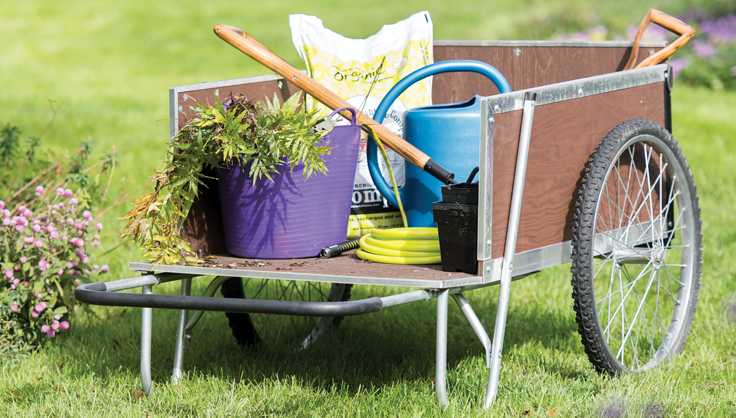FAQs: Garden Tools for Beginners

When it comes to gardening, a few simple tools can make all the difference! Let's dig in to our most frequently asked questions about garden tools:
In This Article
Garden Tool Basics
What are some essential garden tools?
Depending on what type of gardening you are doing, you may need slightly different versions of these items — for example, if you are are gardening solely in planters on the patio, you can stick with a trowel and skip the larger shovel. Here are some essential gardening tools:
- Pruners or Snips: Used for everything from deadheading spent flowers to harvesting herbs, to removing damaged branches, a bladed tool for trimming or pruning is a must for every gardener. Depending on your needs, these could include snips, pruning shears, loppers, hedge trimmers, and hand saws, among others.
- Shovel: If you're going to be digging holes or moving compost from a cart to the garden, a shovel is the efficient way to move large amounts with great ease. (A spade, which has a flattened rectangular head, is a different tool entirely. Spades are very useful for some tasks, but a good shovel is indispensable.)
- Trowel or Cultivator: For more delicate planting and garden tending tasks, you need smaller, but sturdy hand tools. Like a mini shovel, a trowel has a round point and a dished blade, perfect for transplanting seedlings and planting bulbs. A cultivator is like a miniature rake, great for loosening and removing weeds between plants.
- Gloves: Protect your hands! Gloves act as a barrier between your skin and potential hazards in the garden, such as thorns, sharp edges, noxious weeds, or harmful chemicals. Try lightweight and breathable gloves for delicate weeding, or heavy-duty gloves for demanding projects like tree clean-up.
What is the best way to clean garden tools?
- Rinse - First, blast your snips or pruners with a garden hose to pressure wash the dirt off.
- Disinfect – Once clean, disinfect your pruning tool with bleach or isopropyl alcohol, or a gentler 50/50 mix of vinegar and water.
- Wipe Dry - Remove excess moisture with a clean cloth.
- Lubricate - Apply just a few drops of food grade oil to blades and joints to prevent rust from forming — especially for anything that might come into contact with produce that'll be eaten. You can use a few drops of lubricant like WD-40 on the springs and joints of pruners and snips to keep them moving smoothly too.
- Repeat - If used daily, snips and pruners should be cleaned and lubricated weekly during the growing season, to keep them in good working order and to prevent the spread of plant diseases. If you are working with a plant that is known to be diseased, disinfect with bleach or isopropyl alcohol after each use.
What is the best way to store garden tools?
The best thing you can do to prolong the life of your tools is to store them inside (in a shed, garage, or barn) and up off the ground. Rain, snow, and UV exposure from the sun will definitely age tools fast.
How often do you need to sharpen garden tools? Which types of tools need to be sharpened?
You can sharpen pruners, snips, loppers, and gardening knives. If you are a casual gardener, you can get away with a once-a-year sharpening – maybe plan for the end of the season so you can be ready to go once spring planting arrives. If you have a big operation and are regularly pruning or trimming several days a week, you’ll probably want to sharpen a few times throughout the season.
Help! I keep losing my tools in the grass — how can I keep them more organized?
Consider the handle color of a tool before buying it- green or brown tools will be lost easier. If the handle is not already brightly colored, try wrapping it with some brightly colored tape or tying bright flagging onto it. Carrying several tools around the garden? A tool tote, apron, or bucket organizer keeps your tools all within easy reach!
Pruning Tools
What are the different type of pruning tools?
Snips allow you make precision cuts without damaging nearby sems. Pruners are perfect for light pruning and deadheading, as well as harvesting herbs, flowers, fruits, and vegetables. Loppers have large jaw openings to allow for bigger, more substantial cuts. When pruners and loppers don’t make the cut, turn to a pruning saw.
How do different blades work?
There are two styles of blade styles to choose from. Anvil pruners have one blade that's a flattened surface and another like a knife. The sharp blade cuts down through the branch, coming down onto the flattened anvil. Bypass pruners work more like a pair of scissors, with two sharp blades that slide past each other to make the cut. Anvil pruners are strong and durable, but they don't let you get quite as close as the bypass style. Unless they're very sharp, they also tend to crush the plant's tissues rather than make a clean cut. To keep your hands from tiring, look for some sort of spring-action between the handles to help force the blades apart after you make each cut. Pruners come in a range of sizes and weights; select a tool that's appropriately scaled to your hand.
What should I use to cut branches?
Handheld pruners can typically handle branches up to 1/2 inch in diameter. Many loppers can handle branches around 2 inches in diameter. Use a saw for anything larger. Manufacturers will often specify what diameter their particular tool can handle. Of course, a chainsaw can be used for the largest branches and tree trunks.
Watering Tools
Should I use a plastic or metal watering can?
Good news — your plants won't mind either type of watering can! Plastic is economical, lightweight, fairly durable, and can come in many colors. Metal cans will last a long time if cared for correctly, and are generally quite aesthetically pleasing. Consider the size, weight, budget, care level, and look you are going for when selecting a can.
How do I prevent my metal watering can from corroding?
To avoid corrosion, make sure that the water is drained out fully after each use — tipping it over allows it to dry out. Rinse out any fertilizer residue well. If the nozzle has a removable attachment, take it apart to let the entire can dry thoroughly. Bring watering cans indoors during freezing temperatures.
When should I use a sprinkler system versus drip irrigation?
Sprinkler systems are great for broadcasting water evenly and quickly over a large area (i.e. a newly seeded meadow or perennial bed), while drip irrigation provides a more targeted approach. Drip irrigation (or soaker hoses) are excellent at directing water right into the soil, reducing water loss due to evaporation.
Does every hose have the same adapter on the end?
In North America, there is a standard size for hose nozzles, called garden hose thread, or GHT. Adapters for hoses of different sizes are widely available and inexpensive. Standard outdoor faucets are 1/2" or 3/4".
I'd like to use a rain barrel — how do I keep it clean?
Make sure that you have appropriate filters to prevent debris from entering your rain barrel — mesh screening, a clean gutter and spout, and no cracks or holes in the lid of the barrel. Stick to opaque barrels to prevent algae growth (which is not inherently harmful but can clog the system). Use the water rather than storing it for too long to keep it cycling and not stagnant. If necessary, empty the barrel and scrub clean.
My soaker hose is clogged. What should I do?
Soaker hoses can get clogged with soil and mineral deposits that are in your water. If you have mineral deposits you will see visible staining accumulate on your hoses. You can clean this up by soaking your hose in a vinegar solution. You can also flush your hose with running water a few times a season. Remove the end caps and let any debris work itself out of the lines.
Do I need to remove my soaker hoses for the winter?
Drain your soaker hose before freezing weather to prevent the hose from splitting. You can leave in place for the winter or store in a shed/garage. Adding a layer of mulch like straw over it will help protect it from the harsh elements.
How can I prolong the life of my garden hose?
Coiling your hose correctly and storing out of UV rays either in a hose pot or on a reel will help prolong the life of the hose. Drain hoses thoroughly at the end of the season to ensure freezing/thawing cycles don't crack the hose.
Digging Tools
What is the difference between a shovel and a spade?
If you'll ever be digging a hole or moving compost from a cart to the garden, you'll need a shovel. The business end of a shovel is relatively thin, rounded, and comes to a point. The top edge is flat across, and is usually rolled or has a flattened "step" so you can apply some foot pressure if the digging gets tough. The width of a shovel blade may be narrow or broad, but it will always be slightly dished to hold the soil in place. A spade, which has a flattened rectangular head, is a different tool entirely. Spades have flat blades and are generally smaller than shovels. Spades are great for slicing through roil and roots, as well as edging garden beds.
What are the best materials to look for when comparing blades on trowels, shovels, etc.?
Forged steel will last the longest and can handle the heaviest of workloads. Stainless steel will resist rust too. Aluminum is very lightweight but that also makes it prone to bending; not recommended for heavy duty digging.
What is a garden fork?
When you're loosening soil and mixing in compost, the tool of choice is a garden fork. Garden forks are also useful for digging, dividing and transplanting perennials, especially if the soil is moist. Most have 5 or 6 tines that are about ¼-inch square and about 12-inches long. Handles are usually waist-high with a D-grip. A smaller, handheld garden fork (typically called a cultivator) is perfect for loosening the top layer of soil and breaking up weeds.
I want to clean up the edges of my perennial beds – what should I use?
The perfect tool for keeping the edges of your lawn clean and crisp is an edger. Just rock it back and forth to slice through turf grass quickly. As an alternate, you can also use a straight edged spade.
Do I need a garden rake or leaf rake?
A garden rake is made of steel. It will be about 12-inches wide and straight across the top, with 8 or 9 short tines. Garden rakes are perfect for smoothing the soil surface of a newly prepared planting bed or leveling out paths between raised beds. A garden rake is also essential when preparing a new lawn area for seeding, distributing a top-dressing of compost or repairing sections of the lawn or garden. Leaf rakes are lightweight with fan-shaped heads typically made of either plastic, bamboo, or lightweight steel. They are meant to "sweep" leaves, grass clippings, and wood chips. Leaf rakes are perfect for cleaning up debris beween garden rows and beds, and collecting leaves from off the lawn.
Print this Article:
Get the Dirt
Stay up to date on new articles and advice. Please fill out the information below.

